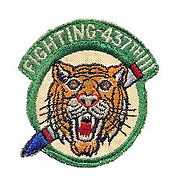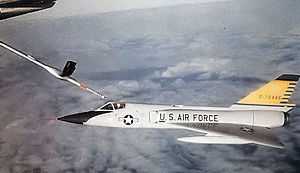437th Fighter-Interceptor Squadron
| 437th Fighter-Interceptor Squadron | |
|---|---|
|
Convair F-106A Delta Dart 57-2486 of the 437th Fighter-Interceptor Squadron[1] | |
| Active | 1944-1946; 1952-1968; 1968 |
| Country |
|
| Branch |
|
| Type | Fighter-Interceptor |
| Role | Air Defense |
| Part of | Air Defense Command |
| Engagements | Pacific Theater of Operations |
| Insignia | |
| Patch showing the 437th Fighter-Interceptor Squadron Emblem |
 |
The 437th Fighter-Interceptor Squadron is an inactive United States Air Force unit. Its last assignment was with 414th Fighter Group at Oxnard AFB, California, where it was inactivated on 30 September 1969.
The squadron was first activated during World War II as the 437th Fighter Squadron, a very long range fighter escort squadron. It deployed to the Pacific Ocean Theater of Operations a month before the Japanese surrender in August 1945, and flew several escort and fighter sweep missions over Japan before the end of the war. It moved to the Philippines after the war ended and was inactivated there in 1946.
History
World War II

The squadron was first established in late 1944 at Seymour Johnson Field, North Carolina as the 437th Fighter Squadron,[2] one of the three original squadrons of the 414th Fighter Group.[3] The 414th was a very long range P-47N Thunderbolt fighter group that trained under I Fighter Command at Selfridge Field, Michigan and Bluethenthal Field, North Carolina.[2]
The squadron deployed by ship to Iwo Jima in the Pacific Ocean Theater of Operations where it became part of Twentieth Air Force as a long-range escort squadron for Boeing B-29 Superfortress bombers engaged in the strategic bombardment of Japan. The extreme length of these missions stretched to fuel capacity of the squadron's Thunderbolts. Lt. Robert Dunnavant, piloting a squadron P-47N, spent the astonishing period of 8 hours and 45 minutes in the air. His aircraft's fuel tanks were so depleted when he eventually reached Iwo Jima, that he dared not try to reach his base at North Field, landing instead at a small US Navy airstrip he located on the coast.
After the Japanese surrender the squadron moved to Luzon where it was assigned to Thirteenth Air Force, with its P-47Ns replaced by North American P-51 Mustangs. It was inactivated in 1946.[2]
Cold War Air Defense


Reactivated in 1952 as an Air Defense Command interceptor squadron at Otis AFB, Massachusetts with F-94C Starfires. It was the first operational F-94C unit. In August 1955 the unit designation was transferred to Oxnard AFB, California and in March 1956 it transitioned into F-89Ds. The squadron received F-89Hs in July 1956 and F-89Js in March 1958.
In January 1960 the squadron was re-equipped with new McDonnell F-101B Voodoo supersonic interceptor, and the F-101F operational and conversion trainer. The two-seat trainer version was equipped with dual controls, but carried the same armament as the F-101B and were fully combat-capable. Operated the Voodoos until April 1968, the aircraft being passed along to the Air National Guard and the squadron inactivated as part of the general drawdown of the ADC active-duty interceptor force.
On 1 July 1968 the 456th Fighter-Interceptor Squadron moved from Castle Air Force Base, California to Oxnard AFB with F-106As and was immediately inactivated. Its personnel and equipment were redesignated to the 437th, which was activated the same day, only to be inactivated on 30 September 1968 and have it personnel and airplanes transferred to the 460th Fighter-Interceptor Squadron, which was activated at Oxnard the same day. The 437th FIS operated the F-106 for only 2 months, making it the shortest-lived F-106 unit.
Lineage
- Constituted as the 437th Fighter Squadron, Single Engine on 5 October 1944
- Activated on 15 October 1944
- Inactivated on 30 September 1946
- Redesignated 437th Fighter-Interceptor Squadron on 14 November 1952
- Activated on 27 November 1952
- Inactivated 29 April 1968
- Activated on 1 July 1968
- Inactivated on 30 September 1968
Assignments
- 414th Fighter Group, 15 October 1944 – 30 September 1946
- 4707th Air Defense Wing, 27 November 1952
- 564th Air Defense Group, 16 February 1953
- 414th Fighter Group, 18 August 1955 – 29 April 1968
- 414th Fighter Group, 1 June 1968 – 30 September 1968
Stations
- Seymour Johnson Field, North Carolina, 15 October 1944
- Selfridge Field, Michigan, 21 November 1944
- Bluethenthal Field, North Carolina, 19 March – 5 June 1945
- North Field (Iwo Jima), 7 July 1945
- Clark Field, Luzon, Philippines, 23 December 1945
- Floridablanca Airfield, Luzon, Philippines, unkn-30 September 1946
- Otis AFB, Massachusetts, 27 November 1952
- Oxnard Air Force Base, California, 18 August 1955 – 29 April 1968
- Oxnard AFB, California, 1 June 1968 – 30 September 1968
Aircraft
|
|
See also
References
Notes
- ↑ This aircraft, seen refueling from a SAC KC-135 in September 1968, was lost on 14 December 1972. There seems to be no documentation that shows the 437th had its own distinctive F-106 tail flash markings. Its tail colors were carried over from the 456th FIS, and became the first markings of the 460th FIS.
- ↑ 2.0 2.1 2.2 Maurer, Combat Squadrons, p. 541-543
- ↑ Maurer, Combat Units, pp. 298–299
Bibliography
| Wikimedia Commons has media related to 437th Fighter Interceptor Squadron (United States Air Force). |
![]() This article incorporates public domain material from websites or documents of the Air Force Historical Research Agency.
This article incorporates public domain material from websites or documents of the Air Force Historical Research Agency.
- Buss, Lydus H.(ed), Sturm, Thomas A., Volan, Denys, and McMullen, Richard F., History of Continental Air Defense Command and Air Defense Command July to December 1955, Directorate of Historical Services, Air Defense Command, Ent AFB, CO, (1956)
- Cornett, Lloyd H; Johnson, Mildred W (1980). A Handbook of Aerospace Defense Organization, 1946–1980. Peterson AFB, CO: Office of History, Aerospace Defense Center.
- A Handbook of Aerospace Defense Organization 1946 - 1980, by Lloyd H. Cornett and Mildred W. Johnson, Office of History, Aerospace Defense Center, Peterson Air Force Base, Colorado
- Maurer, Maurer, ed. (1983) [1961]. Air Force Combat Units of World War II (reprint ed.). Washington, DC: Office of Air Force History. ISBN 0-912799-02-1. LCCN 61060979.
- Maurer, Maurer, ed. (1982) [1969]. Combat Squadrons of the Air Force, World War II (reprint ed.). Washington, DC: Office of Air Force History. ISBN 0-405-12194-6. LCCN 70605402. OCLC 72556.
Further reading
- Grant, C.L., (1961) The Development of Continental Air Defense to 1 September 1954, USAF Historical Study No. 126
- Leonard, Barry (2009). History of Strategic Air and Ballistic Missile Defense. , Vol II, 1955-1972. Fort McNair, DC: Center for Military History. ISBN 978-1-4379-2131-1.
- Leonard, Barry (2009). History of Strategic Air and Ballistic Missile Defense. Vol I. 1945-1955. Fort McNair, DC: Center for Military History. ISBN 978-1-4379-2131-1.
- USAF Aerospace Defense Command publication, The Interceptor, January 1979 (Volume 21, Number 1).
| |||||||||||||||||||||||||||||||||||||||||||


.png)